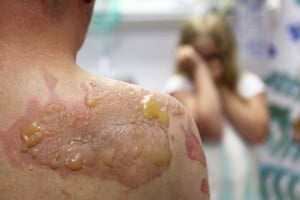Burn Injury
Burn injuries are injuries to the skin or flesh due to fires, heat, electricity, electrical equipment malfunctions, friction, chemicals, explosions, chemical inhalation, smoke inhalation, and radiation. Burn injuries can damage the layers of a person’s skin, the epidermis, dermis and subcutaneous tissue, blood vessels, muscles, nerves, eyes, and lungs. How severe a burn is is based on many factors, including size, depth, cause, affected body area, general health, and age of the burn victim. Arkansas burn injury attorneys take all of these factors into account when examining a claim.
Types of Burns

Burns are typically defined as first, second, third, or even fourth degree burns. These degrees depend on how many layers of tissue and skin are burned; the greater depth and area of the burn, the more severe the burn. Burns to the first layer of skin, the epidermis, are called first degree burns. Second degree burns have two sub-categories: One is a superficial partial thickness burn involving the first and second skin layers, and two involves a deep partial thickness burn to the deeper layers of skin. When all layers of the skin along with the tissue beneath the skin are injured, these are called third degree burns, or “full thickness” burns. When burns are so severe that they extend through the skin damaging muscle, tendons, ligaments, blood vessels, nerves and bones, these are called fourth degree burns. One feature that all degrees of burn injuries share is extreme pain.
Burn injuries are among the most painful injuries a person can experience. The pain can be exquisite, the hospital stay is lengthy, and the danger of infection is constant. If your burn injury was caused by someone other than you, you may be entitled to compensation through Arkansas burn injury attorneys.
Treatment of Burns
The plan of treatment for burn injuries varies, depending on what degree of burn the injury is. First degree burns can typically be treated with basic painkillers, while severe burns could require more aggressive and continuous treatments including admission into burn centers. Full thickness burns, third and fourth degree burns, typically require surgery, including skin grafting along with 24 hour supervision to give intravenous fluids, medications and wound care because of the high risk of infection, such as cellulitis, pneumonia, respiratory failure and urinary tract infections. Burn injury survivors are left with hair loss, significant scarring, and other permanent disfigurements. Burn victims often suffer from post traumatic emotional and psychological disorders, including depression. Thus, medical treatment for burn injuries often requires various medical specialists, therapists, among other caregivers, which can be a costly and lengthy recovery process. Arkansas burn injury attorneys want to get you compensated for all of these expenses and more.
Arkansas Burn Injury Attorneys
When the burn injury was caused by another person’s negligence or carelessness, you may be entitled to receive monetary compensation for your medical bills, pain and suffering, and lost income. Our affiliated Arkansas burn injury attorneys have experience handling many burn injury claims. They will use a network of specialists to help evaluate your case and help determine the cost of the continuous medical care you will need after a burn injury. Contact Arkansas burn injury attorneys today.





